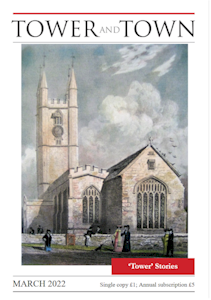

Tower and Town, March 2022 (view the full edition) (view the full edition)Nature Notes: Ring Ouzels on Liddington HillLiddington Castle is an Iron Age hill fort 13 miles due north of Marlborough: at 909 feet it is the highest point in the Borough of Swindon. Sited on a commanding high point close to the Ridgeway and covering an area of 7 acres, the castle was one of the earliest hill forts in Britain, with first occupation dating back to the 7th century BC. The earthworks consist of a relatively simple oval bank of timber and earth fronted by a ditch, with opposing causewayed entrances to the east and west. Liddington Hill was a favourite haunt of local natural history writer Richard Jefferies, who spent much of his spare time walking through the wide chalk expanses of the Marlborough Downs. Nowadays, as well as attracting energetic hikers and intrepid hang-gliding people it has a special attraction for local birdwatchers, particularly in early Spring, when birds appear on migration. While wintering fieldfares are already flying north to breed in Scandinavia, Russia and Iceland another thrush species is stopping off on its annual journey from its wintering haunts in Spain and North West Africa: the charismatic ring ouzel - the 'mountain blackbird.' From late March to early April a walk following a hedgerow of ivy-clad hawthorn and dogwood off the B road to Bishopstone is best undertaken before the hang-gliders arrive. As like as not a blackbird will fly off ahead of you and a yellowhammer appears on a bare branch. On the slope to the left a smart male wheatear shows its white rump as it flies to a chalky outcrop and a flock of meadow pipits rise up from the ground. With luck another thrush, with a silver-grey wing panel, will suddenly shoot out from the middle of a seemingly empty hawthorn bush with harsh 'chack, check' calls. It flies strongly towards the castle, stopping on another bush before dropping briefly to the ground. It is then that the white crescent on its breast confirms what it is - a beautiful male ring ouzel. It is primarily a bird of the uplands, where it breeds mainly in steep-sided valleys, crags and gullies from near sea-level in the far north of Scotland up to 1,200 m in the Cairngorms. National surveys show that numbers have decreased by 72 % since 1988, with a 2016 population estimate of around 5,500 territories in Britain. Hikers, hang-gliders, over-enthusiastic birders take care: give this special bird a chance to rest and refuel!  Robin Nelson |